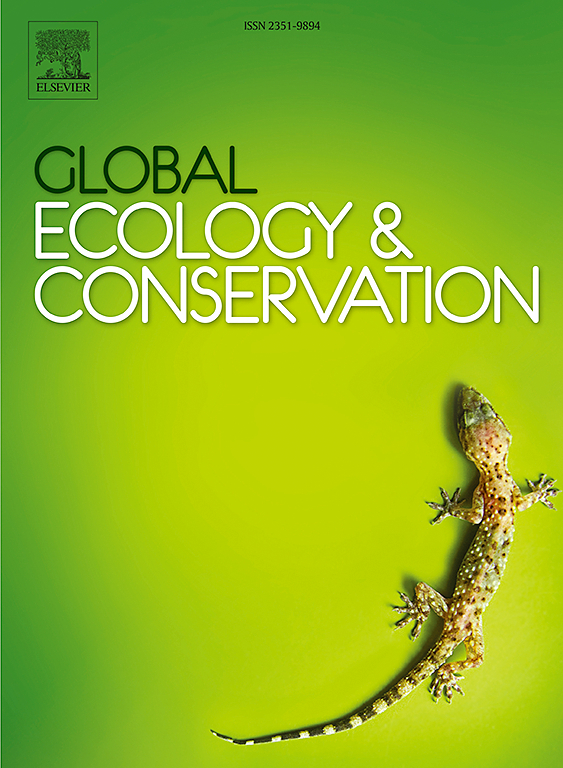菜子湖和盛金湖豆鹅越冬期间重金属、肠道微生物群落和代谢组的比较分析
IF 3.4
2区 环境科学与生态学
Q1 BIODIVERSITY CONSERVATION
引用次数: 0
摘要
重金属是对迁徙水鸟健康产生重大影响的主要环境挑战。盛金湖和彩子湖位于长江沿岸,是东亚-澳大拉斯迁徙路线上重要的停靠地和越冬湿地。对生津湖( = 15)和菜子湖( = 15)的越冬豆鹅(Anser fabalis)重金属、微生物群落和代谢产物进行了分析。在粪便样本中,砷、铬和汞的浓度在两个地点之间存在显著差异,而Cd和Pb的水平没有显著差异。变形菌门、放线菌门、厚壁菌门和拟杆菌门是鹅肠道微生物的优势门。shannon - wiener’s指数和PLS-DA分析结果显示,两个地点的鹅之间存在显著差异。线性判别分析效应大小(LEfSe)检验表明,生津湖鹅中显著富集黄杆菌、假单胞菌和Janthinobacterium,而菜子湖鹅中显著富集节杆菌和孢子菌。LC-MS结果表明,脂质、类脂分子、有机酸及其衍生物和有机杂环化合物在粪便代谢谱中占主导地位。PLS-DA结果显示,所有的圣金湖鹅和彩子湖鹅都产生了不同的群集。根据京都基因与基因组百科全书(KEGG)的代谢途径,在圣金湖和菜子湖样本中发现了135条不同的途径。相关分析表明,重金属对肠道微生物群落和代谢物组成有影响。肠道代谢物与微生物之间也存在显著的相关性。因此,本研究可为迁徙水鸟提供湿地生态系统环境污染预警。本文章由计算机程序翻译,如有差异,请以英文原文为准。
Comparative analysis of heavy metals, gut microbial community and metabolome between bean geese (Anser fabalis) wintering at Caizi and Shengjin lakes, China
Heavy metals are major environmental challenges with significant health implications for migratory waterbirds. Shengjin and Caizi Lakes, located along the Yangtze River, are important stopover and wintering wetlands for migratory waterbirds in the East Asia-Australasian Flyway. The heavy metal, microbial communities, and metabolites in wintering bean geese (Anser fabalis) were analysed in Shengjin (n = 15) and Caizi Lakes (n = 15). In the faecal samples, As, Cr, and Hg concentrations differed significantly between the two sites, whereas the levels of Cd and Pb were not significantly different. Proteobacteria, Actinobacteria, Firmicutes, and Bacteroidota were the dominant gut microbial phyla in geese. The Shannon![]() Wiener’s index and PLS-DA analysis results showed significant differences between geese at the two sites. Linear discriminant analysis Effect Size (LEfSe) tests showed that Flavobacterium, Pseudomonas, and Janthinobacterium were significantly enriched in the Shengjin Lake geese, whereas Arthrobacter and Sporosarcina were significantly enriched in the Caizi Lake geese. The LC-MS results indicated that lipids, lipid-like molecules, organic acids and derivatives, and organoheterocyclic compounds were the dominant in faecal metabolic profiles. PLS-DA revealed that all Shengjin Lake and Caizi Lake geese produced distinct clusters. A total of 135 pathways were found to be different between the Shengjin and Caizi lake samples, according to the Kyoto Encyclopedia of Genes and Genomes (KEGG) metabolic pathway. Correlation analysis revealed that heavy metals affected the gut microbial community and metabolite composition. A significant correlation was also observed between the gut metabolites and microorganisms. Therefore, our study provides early warnings of environmental pollution of wetland ecosystems for migratory waterbirds.
Wiener’s index and PLS-DA analysis results showed significant differences between geese at the two sites. Linear discriminant analysis Effect Size (LEfSe) tests showed that Flavobacterium, Pseudomonas, and Janthinobacterium were significantly enriched in the Shengjin Lake geese, whereas Arthrobacter and Sporosarcina were significantly enriched in the Caizi Lake geese. The LC-MS results indicated that lipids, lipid-like molecules, organic acids and derivatives, and organoheterocyclic compounds were the dominant in faecal metabolic profiles. PLS-DA revealed that all Shengjin Lake and Caizi Lake geese produced distinct clusters. A total of 135 pathways were found to be different between the Shengjin and Caizi lake samples, according to the Kyoto Encyclopedia of Genes and Genomes (KEGG) metabolic pathway. Correlation analysis revealed that heavy metals affected the gut microbial community and metabolite composition. A significant correlation was also observed between the gut metabolites and microorganisms. Therefore, our study provides early warnings of environmental pollution of wetland ecosystems for migratory waterbirds.
求助全文
通过发布文献求助,成功后即可免费获取论文全文。
去求助
来源期刊

Global Ecology and Conservation
Agricultural and Biological Sciences-Ecology, Evolution, Behavior and Systematics
CiteScore
8.10
自引率
5.00%
发文量
346
审稿时长
83 days
期刊介绍:
Global Ecology and Conservation is a peer-reviewed, open-access journal covering all sub-disciplines of ecological and conservation science: from theory to practice, from molecules to ecosystems, from regional to global. The fields covered include: organismal, population, community, and ecosystem ecology; physiological, evolutionary, and behavioral ecology; and conservation science.
 求助内容:
求助内容: 应助结果提醒方式:
应助结果提醒方式:


